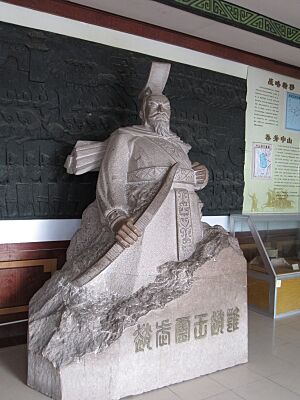King Wuling of Zhao facts for kids
Quick facts for kids King Wuling of Zhao趙武靈王 |
|||||||||
|---|---|---|---|---|---|---|---|---|---|

Statue of King Zhao Wuling in Congtai Park
|
|||||||||
| Lord of Zhao | |||||||||
| Reign | 318–299 BCE | ||||||||
| Predecessor | Marquess Su | ||||||||
| Successor | King Huiwen | ||||||||
| King of Zhao | |||||||||
| Reign | 323–318 BCE | ||||||||
| Predecessor | New title | ||||||||
| Successor | vacant (next: King Huiwen) | ||||||||
| Marquess of Zhao | |||||||||
| Reign | 325–323 BCE | ||||||||
| Predecessor | Marquess Su | ||||||||
| Successor | Crown as the king | ||||||||
| Born | Unknown | ||||||||
| Died | 295 BCE | ||||||||
| Spouse | Consort Han Queen Hui |
||||||||
| Issue | Zhao Zhang, Lord Anyang King Huiwen of Zhao Zhao Sheng, Lord Pingyuan Zhao Pao, Lord Pingyang |
||||||||
|
|||||||||
| House | Ying | ||||||||
| Dynasty | Zhao | ||||||||
| Father | Marquess Su of Zhao | ||||||||
King Wuling of Zhao (simplified Chinese: 赵武灵王; traditional Chinese: 趙武靈王), whose personal name was Zhao Yong, was an important ruler of the Zhao state in ancient China. He ruled from 325 BCE to 299 BCE. His time as king is famous for a big change he made. He introduced new military uniforms and fighting styles. This change was called "Wearing the Hu (styled) Attire and Shooting from Horseback." It made his army much stronger.
King Wuling was the son of Marquess Su. He became ruler in 325 BCE. This was during the Warring States period, a time when many states in China were fighting each other. King Wuling was the first ruler of Zhao to call himself "king." He later gave up this title but got it back as part of his name after he died.
Contents
Why King Wuling Made Changes
In the early years of King Wuling's rule, the Zhao state faced many problems. Nomadic tribes from the north often attacked them. These tribes included the Donghu, Linhu, Loufan, and Beidi people. They were skilled at riding horses and fighting. These attacks likely inspired King Wuling to think about new ways to protect his country.
King Wuling also learned a tough lesson from a big defeat. In 318 BCE, the Zhao army lost badly to the Qin state. This made King Wuling realize his army needed to improve. He had called himself "king" earlier, but after this defeat, he felt he didn't have the power of a true king yet.
The Great Military Reforms
In 307 BCE, King Wuling started his famous reforms. These changes were mostly about making the army better at fighting. Before this, Zhao soldiers on horseback still wore long robes. These robes were not good for fighting or riding.
King Wuling ordered everyone in the army to change their clothes. They had to wear the "Hu style" of dress. This included pants, belts, boots, and fur caps. These clothes were much more practical for riding and fighting. He also created a new part of the army: the cavalry. These soldiers rode horses and were trained to shoot arrows while riding. This was a very new and effective way to fight.
Dealing with Opposition
Not everyone liked King Wuling's new ideas. Many officials and even his own uncle, Lord Cheng, were against the changes. They thought it was wrong to copy the clothing of "barbaric" tribes. They believed it went against old traditions. Lord Cheng even refused to come to court because he was so upset.
King Wuling worked hard to convince them. He said that there isn't just one way to rule a country. He believed that to help the country, you don't always have to follow old rules. He wore the new "barbaric" clothes himself. He even visited Lord Cheng and gave him a suit of the new clothing. Eventually, Lord Cheng agreed, and the arguments stopped.
Success of the Reforms
King Wuling's reforms made the Zhao army much stronger. In the same year, Zhao attacked the state of Zhongshan and took several cities. In 306 BCE, the Zhao army went on expeditions into the northern lands. They were very successful. The kings of the Loufan and Linhu tribes surrendered. Their lands became part of Zhao.
Zhao continued to expand. In 304 BCE, they took control of parts of the Yellow River region from other tribes. King Wuling created new areas called prefectures in these conquered lands. In just over five years, King Wuling had made his country much bigger. He had also forced the Loufan and Linhu kings to join his side. He even added their skilled nomadic warriors to his own army.
King Wuling's Later Years and Death
In 299 BCE, King Wuling decided to step down from the throne. He gave the kingship to his younger son, Zhao He, who became King Huiwen of Zhao. Zhao He was only 12 years old at the time. King Wuling still held a lot of power, though. He called himself the "Lord Father." This was like a retired king who still guides the country.
As the "Lord Father," he traveled to neighboring countries. He even secretly visited the powerful Qin state, pretending to be a regular messenger. In 296 BCE, he successfully took over the state of Zhongshan.
In 295 BCE, a sad event happened. King Wuling's older son, Zhao Zhang, rebelled against the new King Huiwen. The rebellion was defeated by the prime minister, Lord Cheng, and his general, Li Yu. Zhao Zhang ran to his father's palace for safety. King Wuling felt sorry for him and let him stay.
Lord Cheng and Li Yu's forces surrounded the palace. They killed Zhao Zhang. Fearing punishment, Li Yu ordered the palace to be sealed off. No food or water was allowed in. King Wuling was trapped inside and died after some time. This tragic event is known as the Shaqiu Incident.

